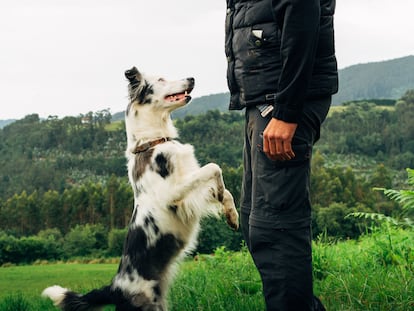Does your dog really care about its birthday? The mistake of treating pets like humans
Many people think that humanizing their furry companions is the best way to care for them, but the truth is that they are happier just being what they are: animals

They call them “pet influencers,” and they have been steadily gaining ground on social media. They are adorable, immune to controversy and way cheaper to hire than their human counterparts. There is Jiffpom, with 9.4 million followers on Instagram; Doug The Pug, which exceeds 3.6 million; and Tika the Iggy with one million and counting. The three have in common the fact that they are extremely cute, a gold mine as a business, and also that, although they are dogs, what their followers love is to see them act like humans.
This phenomenon is known as the anthropomorphism or humanization of pets. This describes what happens when people attribute a series of characteristics, conditions or qualities typical of people to animals. Examples abound; we do not even have to linger on the extreme cases such as Paris Hilton’s dogs, who have their own mansion, or the guests that stay at the D Pet hotels, which offer a spa with treatments for dogs, organic treats, photo shoots or rides in Ferraris, Lamborghinis, Porsches or Rolls-Royces. Anywhere you look, it is not very hard to see perfectly healthy canines being carried around in carts or bags, dressed as people, with perfume or tiny painted nails, all duly immortalized on social media, quite often in the pet’s own account in which, to boot, they “speak” in the first person – as if they were precisely that, persons, instead of dogs.
“Each species has its own needs and a way of perceiving the world and communicating differently from how we humans do. If we do not take these aspects into account and just pretend that they are the same as us, we will be directly affecting their well-being, as good as our intentions are,” explains Alicia Torrano Cano, veterinarian, canine advisor and co-founder of the canine school El Perro Limón, in Spain. A person who treats their pet like this does so convinced that they are doing what is best; that they are pampering the animal. According to human anthropocentric logic, dogs perceive the world in the same way that we do and, therefore, carrying them around in a cart – so they do not need to walk or get their paws dirty – with perfume and a beautiful coat is a way to take care of them, even to provide them with a luxury. However, the real luxury for the dog would probably be rolling around in mud, running without a leash and sniffing everything and anything within reach.
But that is precisely what they cannot do. “The most common thing is not allowing our dogs to act in ways that are logical for them, just because they are not logical for us,” says Torrano Cano. Behaviors such as rummaging through the garbage, digging, exploring with their mouths when they are puppies or jumping into puddles are absolutely natural for them. “Does that mean that I have to let them do whatever they want? Of course not, but it is very important that we take this into account and assess how much we demand of them, how much we are willing to give up for them, how we communicate when we ask our dog not to act on one of these behaviors and what repercussions this can have on their well-being or their development,” she says.
Nor should we fall into Manichaeism. Anyone who lives with a pet almost inevitably engages in a certain degree of humanization; let the one who does not say “good morning” to their furry companion cast the first stone. A study called Anthropomorphized species as tools for conservation: utility beyond prosocial, intelligent and suffering species, published in the journal Biodiversity and Conservation in 2013, found that a certain degree of humanization can be useful so that people give meaning to their interactions with the non-human world, favoring empathy and a commitment to the conservation of biodiversity. “Often, treating them as humans makes the person empathize with them and accompany them, for example, in situations in which the dog is very afraid,” says Cristina Aranguren, canine educator and creator at the Rumbo Awen school in Spain.
However, sometimes that empathy goes too far. Is that dog really comfortable in a Santa Claus suit? Does he like to wear a crown and celebrate his birthday surrounded by a bunch of people? Is he really comfortable in a shopping mall? Both experts agree that it depends on the dog and the situation. “In general, I think that environments with a high density of people and lots of bustle are not appropriate for dogs,” Aranguren points out. “Another thing,” she continues, “is that some tolerate them and even get along very well in them. But being able to deal with a situation or an environment is one thing, and it being beneficial for the individual is another.”
It is important to pay attention to the animal; in its language, it communicates whether or not it is comfortable. “Some dogs are very expressive and you can immediately see several signs of discomfort: smacking, looking away, yawning, shaking their body, whimpering and even actively asking for help by trying to climb on our lap or looking at us,” Aranguren adds. Another resource – which may be less obvious to humans – is to disconnect: “Some dogs can develop coping strategies such as taking refuge in an activity to detach themselves from a situation from which they cannot get out,” she explains. If all the dog wants to do is be with a toy while you try to make it pose for the thousandth picture, you may be witnessing an abstraction strategy. It is not that different from a person who, fed up with being asked at the family dinner why they are still single, takes their cell phone and goes deep into scrolling mode.
The key, as with almost everything, is balance. It is not the same to subject a dog to an annoying situation from time to time than to do it continuously and without paying heed to the signs of discomfort. “The consequence is living with dogs that don’t feel understood, with the repercussions that this has on an emotional level and on our relationship with them. When this happens, we find dogs that live in a state of constant frustration and with very high levels of daily stress, showing difficulties to manage different situations or what is usually called behavioral problems,” states Torrano Cano.
Those behavioral problems that populate the consultations of ethologists and veterinarians are, in a very high percentage, caused by communication problems between humans and dogs. We must not forget that they are not people, they do not communicate like we do and they do not have to like the same things that we do. “We know that you do it with the best of intentions, but if we want what’s best for our dog, we must love it for what it is: a dog,” Torrano Cano concludes.
Sign up for our weekly newsletter to get more English-language news coverage from EL PAÍS USA Edition
Tu suscripción se está usando en otro dispositivo
¿Quieres añadir otro usuario a tu suscripción?
Si continúas leyendo en este dispositivo, no se podrá leer en el otro.
FlechaTu suscripción se está usando en otro dispositivo y solo puedes acceder a EL PAÍS desde un dispositivo a la vez.
Si quieres compartir tu cuenta, cambia tu suscripción a la modalidad Premium, así podrás añadir otro usuario. Cada uno accederá con su propia cuenta de email, lo que os permitirá personalizar vuestra experiencia en EL PAÍS.
¿Tienes una suscripción de empresa? Accede aquí para contratar más cuentas.
En el caso de no saber quién está usando tu cuenta, te recomendamos cambiar tu contraseña aquí.
Si decides continuar compartiendo tu cuenta, este mensaje se mostrará en tu dispositivo y en el de la otra persona que está usando tu cuenta de forma indefinida, afectando a tu experiencia de lectura. Puedes consultar aquí los términos y condiciones de la suscripción digital.
More information
Últimas noticias
Most viewed
- Sinaloa Cartel war is taking its toll on Los Chapitos
- Oona Chaplin: ‘I told James Cameron that I was living in a treehouse and starting a permaculture project with a friend’
- Reinhard Genzel, Nobel laureate in physics: ‘One-minute videos will never give you the truth’
- Why the price of coffee has skyrocketed: from Brazilian plantations to specialty coffee houses
- Silver prices are going crazy: This is what’s fueling the rally











































